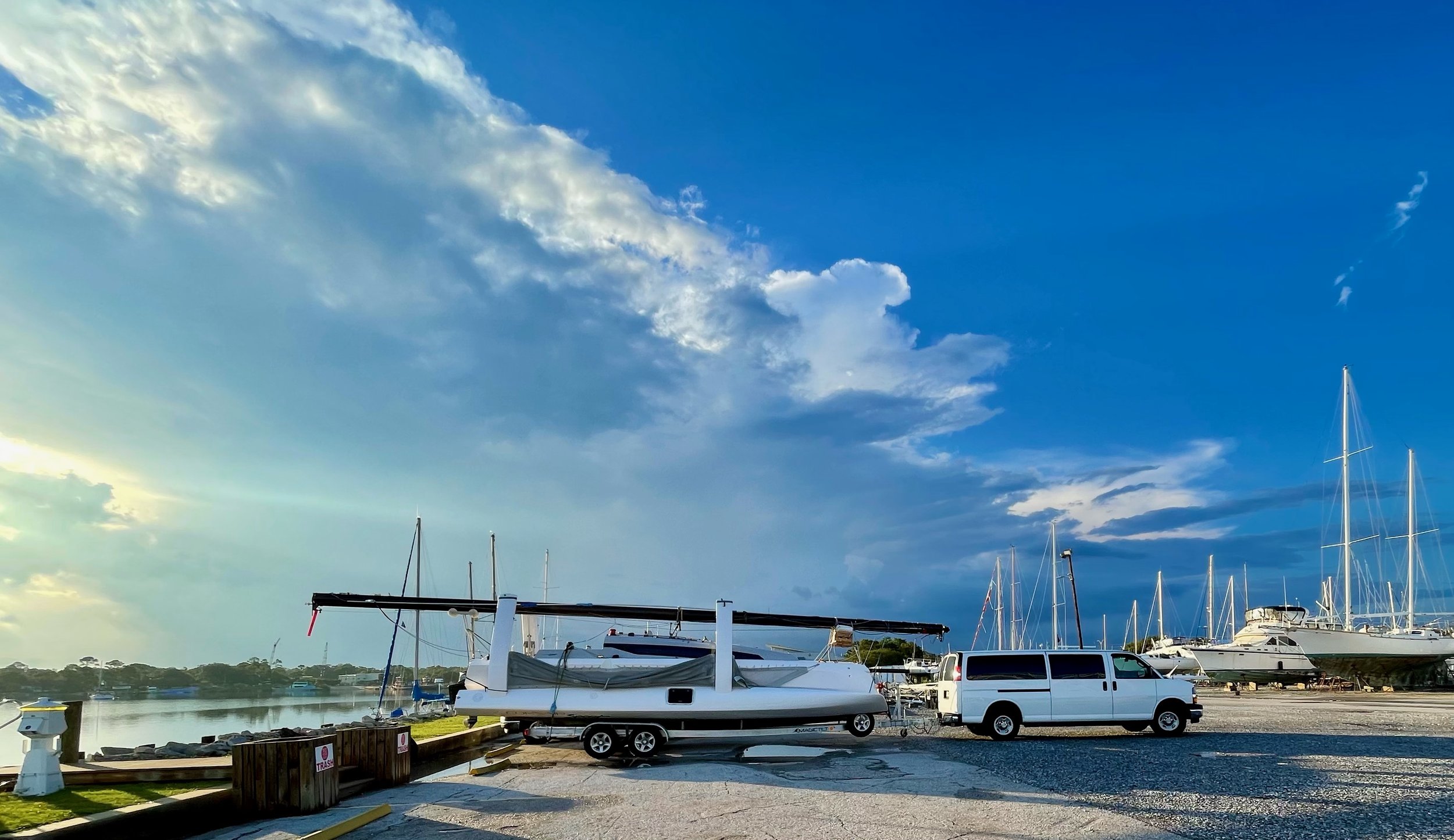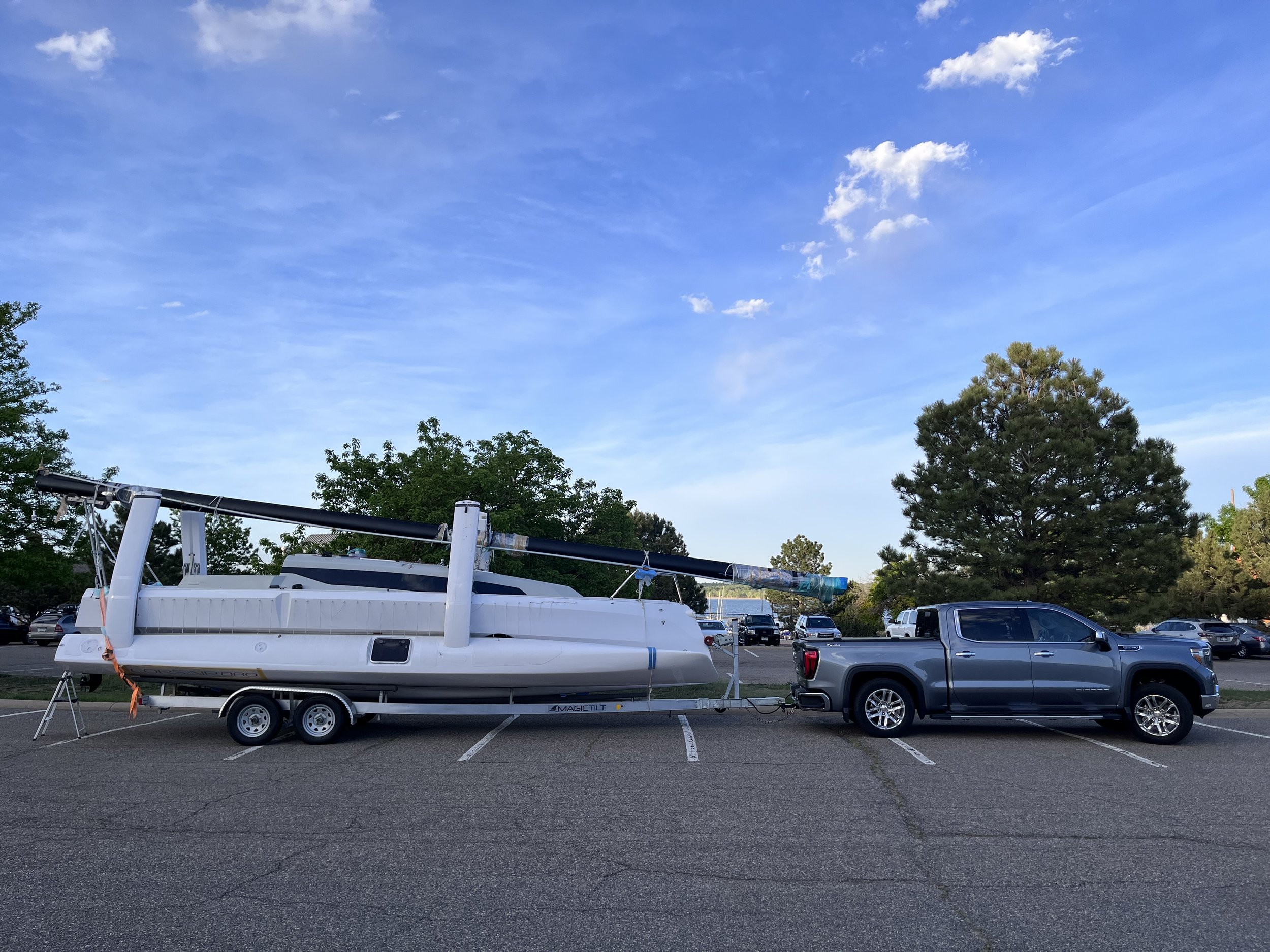Preparing a Corsair for interstate travel is just as important as preparing it for a blue water delivery. Severe weather and bumpy road conditions can take a toll on any boat and its inventory if unprepared.
Insurance Coverage
The owner of a boat is responsible for her as well as her trailer and potentially any damage either may cause to persons or property during transit. Double check your coverage – especially if a third party will be towing your boat. Confirm commercial transporters carry commercial liability and property damage insurance.
Weight & Gear
Be smart about the gear and weight you’re hauling in the boat. Too much gear is going to increase the chances of damage and will without question add to the weight and fuel costs.
Having weight in the wrong place in the boat can cause the trailer to sway back and forth. The rule of thumb is to have about 10-15% of the GTW (gross trailer weight) on the hitch. If the trailer is swaying, gear can be moved forward inside the boat to help reduce or eliminate this, as can adjusting the height of the drawbar and hitch ball.
Secure gear as low as possible in the boat – the heaviest items the lowest- just as on the water.
Any fragile items should be wrapped or removed. Think about the trailer and boat bouncing through potholes and over rough railroad crossings. Could it break? Then wrap it and pack it appropriately.
Prevent chafe and scratches. Any items with sharp edges should be wrapped or otherwise protected from damaging other gear or the boat’s interior.
Empty your tanks! No fuel (if possible, and if transporting into other countries, it may not be allowed), no gray, black, or fresh water either.
Batteries and outboard motors should be removed or properly secured.
Remove any perishables and any unsealed food. No one wants insects, vermin, or even bears in their boat (it’s possible where we often trailer boats)!
Use quality painters’ tape or bungees to secure doors, cabinets, folding tables, and other large movable bits open or closed if necessary.
Secure Openings
Secure all hatches and opening ports, and seal any through hulls or other external openings with colored 3M vinyl tape. Why tempt wasps or other creatures from crawling in there? This tape won’t leave residue if it’s removed within a few days. It’s also great for securing rigging that you don’t want to stow (see next section). Use it “inside out” if you’re planning to leave it wrapped in place for any period of time so the adhesive isn’t left behind on your boat.
Boat & Systems, Rigging & Foils
Shut off or disconnect batteries, and ensure batteries are strapped down properly. Cover at least the positive terminal securely so no loose metal object can make contact with it. Battery tie-down brackets are often made from plastic and are broken. Also check to ensure the screws are tight. Now is a good time to replace and/or re-bed them if the screw holes are stripped.
Winterize engines and plumbing if it’s that time of year. When in doubt, check the manual for any systems you’re unsure about.
All stays and shrouds are best removed, coiled, and stowed in the cabin - preferably in a box or old sail bag. Stainless rigging can mar gel coat and it’s often dirty enough to stain fabric cushions. Fiber rigging is fine to be left out on deck as long as it is coiled and secured though it may get unnecessarily filthy if there is any rain during your road trip.
Masthead instruments (Windex, anemometer, antenna, etc.) removed and stowed. Close or otherwise cover plugs and terminals to prevent water ingress.
Ensure the mast and boom secured to avoid any chips, scrapes or scratches. The same goes for the floats. Coil your halyards and sheets and secured any of these left on deck to prevent vibration and banging as well as chafing. Stow fenders and dock lines in the cabin, and tie up the nets securely or remove them if the boat will be on its trailer for an extended period.
Consider sand, gravel, and other road debris. Install mud flaps and chip protection. It’s easier and cheaper to peel off some stretch or shrink wrap (or even masking tape) than making gel coat repairs.
Properly secure the daggerboard by allowing its weight to be supported by the trailer bunk and then snug the hoisting and lowering lines as applicable. Remove the rudder and cassette and store separately in padded backs on the cabin sole.
Remove any extra gear, equipment, and electronics from the mast, boom, nets, pulpits, and stanchions as appropriate.
Finally, secure the boat firmly to the trailer in a minimum of five points of connection, e.g. bow strap plus two ratchet straps or tie-down lines. Please refer to your boat’s owner’s manual.
Know your Dimensions
Overall height, width, length and approximate all-up weight
Confirm the tow vehicle is up to the task
Ensure that no more than about 5 feet of mast is extending beyond the transom.
Tires and Wheels
Spare tire and wheel mounted to trailer?
Do you have the proper lug wrench and jack to lift the trailer and remove the wheels?
Is the tread good and air pressure correct per the info on the tire’s sidewall? Is there any dry rot or signs of damage?
Trailer
Bearings inspected and greased? If not, think about the miles since last service. If you’re unsure, check them. It’s a lot easier to do in the driveway deal with a problem on the side of a highway. A failed bearing can destroy an axle and in some cases cause the wheel come off while driving.
Lights tested?
Brakes tested?
Is the brake pad thickness OK?
Lugs torqued to spec?
Tongue weight OK? Too little and the trailer may sway; too much puts unnecessary wear on the tow vehicle’s suspension.
Safety chains with suitable attachments including emergency break-way when required?
Fine Print
Please read your owner’s manuals for other tips and instructions. We don’t provide any guarantees that this list is all-inclusive or will prevent any problems. It’s just a guide. Use it at your own risk, and call us if we can help answer your questions.
Corsair Trimaran Education:
If you're interested in knowing more about the Corsair 880 or the Corsair 880 Sport contact our USA trimaran expert Richard Allen / info@180marine.com
Richard is a long-standing Corsair trimaran expert with vast experience across all models.
0 Likes




